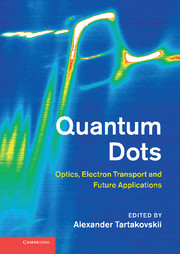Book contents
- Frontmatter
- Contents
- List of contributors
- Preface
- Part I Nanostructure design and structural properties of epitaxially grown quantum dots and nanowires
- Part II Manipulation of individual quantum states in quantum dots using optical techniques
- 4 Studies of the hole spin in self-assembled quantum dots using optical techniques
- 5 Resonance fluorescence from a single quantum dot
- 6 Coherent control of quantum dot excitons using ultra-fast optical techniques: the role of acoustic phonons
- 7 Holes in quantum dot molecules: structure, symmetry, and spin
- Part III Optical properties of quantum dots in photonic cavities and plasmon-coupled dots
- Part IV Quantum dot nano-laboratory: magnetic ions and nuclear spins in a dot
- Part V Electron transport in quantum dots fabricated by lithographic techniques from III–V semiconductors and graphene
- Part VI Single dots for future telecommunications applications
- Index
- References
5 - Resonance fluorescence from a single quantum dot
from Part II - Manipulation of individual quantum states in quantum dots using optical techniques
Published online by Cambridge University Press: 05 August 2012
- Frontmatter
- Contents
- List of contributors
- Preface
- Part I Nanostructure design and structural properties of epitaxially grown quantum dots and nanowires
- Part II Manipulation of individual quantum states in quantum dots using optical techniques
- 4 Studies of the hole spin in self-assembled quantum dots using optical techniques
- 5 Resonance fluorescence from a single quantum dot
- 6 Coherent control of quantum dot excitons using ultra-fast optical techniques: the role of acoustic phonons
- 7 Holes in quantum dot molecules: structure, symmetry, and spin
- Part III Optical properties of quantum dots in photonic cavities and plasmon-coupled dots
- Part IV Quantum dot nano-laboratory: magnetic ions and nuclear spins in a dot
- Part V Electron transport in quantum dots fabricated by lithographic techniques from III–V semiconductors and graphene
- Part VI Single dots for future telecommunications applications
- Index
- References
Summary
Introduction
Quantum optics provides a complete description of the resonant interaction of light and a material system. The light scattered as a result of this interaction – the resonance fluorescence – provides a means to monitor and affect the material system's dynamics and also allows for the generation of nonclassical states of the electromagnetic field. Initial theoretical studies characterizing resonance fluorescence addressed fundamental questions regarding the necessity of quantizing the electromagnetic field. This is a particularly illustrative period in optical physics where multiple theories existed that might describe resonance fluorescence – semi-classical optical Bloch equations [1, 2] or quantum electrodynamics [4, 3] – and experimental evidence was necessary to identify the appropriate theoretical framework. Indeed, experiments in 1974 and 1977 investigating the resonance fluorescence lineshape [5, 6] and the photon statistics of the scattered light [7] vindicated the full quantum electrodynamical description of light-matter interaction over other models. In the subsequent 30 years, resonance fluorescence has been used as a high-resolution spectroscopic probe of a variety of physical systems, as a means to investigate quantum coherence in atomic gases and, with the current interest in quantum information science (QIS), as a tool for quantum-state preparation, measurement and control in trapped ions [8].
During this same time period, advances in material science have ushered in an era where it is possible to grow and fabricate solid-state devices at length scales commensurate with the quantum confinement of electrons and holes. It is only recently that resonance fluorescence has been observed from the prototypical artificial nanostructure exhibiting three-dimensional quantum confinement – a single semiconductor quantum dot (QD) [9].
- Type
- Chapter
- Information
- Quantum DotsOptics, Electron Transport and Future Applications, pp. 86 - 102Publisher: Cambridge University PressPrint publication year: 2012



